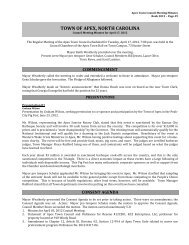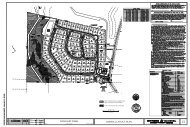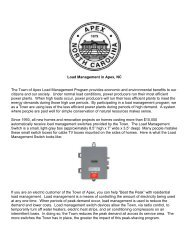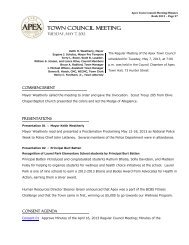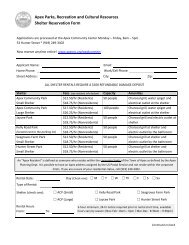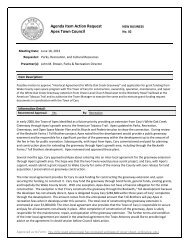Parks, Recreation, Greenways, and Open Space ... - Town of Apex
Parks, Recreation, Greenways, and Open Space ... - Town of Apex
Parks, Recreation, Greenways, and Open Space ... - Town of Apex
You also want an ePaper? Increase the reach of your titles
YUMPU automatically turns print PDFs into web optimized ePapers that Google loves.
<strong>Parks</strong> & <strong>Recreation</strong> Plan Update | 2013stormwater management services may not exceedthe costs incurred to provide these services.Streetscape Utility FeesStreetscape Utility Fees could help support streetscapemaintenance <strong>of</strong> the area between the curb <strong>and</strong> theproperty line through a flat monthly fee per residentialdwelling unit. Discounts would be available for senior<strong>and</strong> disabled residents. Non-residential customerswould be charged a per-foot fee based on the length<strong>of</strong> frontage streetscape improvements. This amountcould be capped for non-residential customerswith extremely large amounts <strong>of</strong> street frontage.The revenues raised from Streetscape Utility Feeswould be limited by ordinance to maintenance (orconstruction <strong>and</strong> maintenance) activities in support<strong>of</strong> the streetscape.Impact FeesDevelopers can be required to pay impact feesthrough local enabling legislation. Impact fees, whichare also known as capital contributions, facilitiesfees, or system development charges, are typicallycollected from developers or property owners at thetime <strong>of</strong> building permit issuance to pay for capitalimprovements that provide capacity to serve newgrowth. The intent <strong>of</strong> these fees is to avoid burdeningexisting customers with the costs <strong>of</strong> providing capacityto serve new growth so that “growth pays its ownway.”In North Carolina, impact fees are designed to reflectthe costs incurred to provide sufficient capacityin the system to meet the additional needs <strong>of</strong> agrowing community. These charges are set in a feeschedule applied uniformly to all new development.Communities that institute impact fees must developa sound financial model that enables policy makersto justify fee levels for different user groups, <strong>and</strong> toensure that revenues generated meet (but do notexceed) the needs <strong>of</strong> development. Factors used todetermine an appropriate impact fee amount caninclude: lot size, number <strong>of</strong> occupants, <strong>and</strong> types <strong>of</strong>subdivision improvements. A developer may reducethe impacts (<strong>and</strong> the resulting impact fee) by payingfor on- or <strong>of</strong>fsite pedestrian improvements that willencourage residents/tenants to walk or use transitrather than drive. Establishing a clear nexus orconnection between the impact fee <strong>and</strong> the project’simpacts is critical in avoiding a potential lawsuit.ExactionsExactions are similar to impact fees in that theyboth provide facilities to growing communities.The difference is that through exactions it canbe established that it is the responsibility <strong>of</strong> thedeveloper to build the greenway or pedestrian facilitythat crosses through the property, or is adjacent tothe property being developed.In-Lieu-Of FeesAs an alternative to requiring developers to developa greenway or pedestrian facility that would servetheir development, some communities providea choice <strong>of</strong> paying a front-end charge for <strong>of</strong>f-siteprotection <strong>of</strong> pieces <strong>of</strong> the larger system. Paymentis generally a condition <strong>of</strong> development approval<strong>and</strong> recovers the cost <strong>of</strong> the <strong>of</strong>f-site l<strong>and</strong> acquisitionor the development’s proportionate share <strong>of</strong> thecost <strong>of</strong> a regional facility serving a larger area. Somecommunities prefer in-lieu-<strong>of</strong> fees. This alternativeallows community staff to purchase l<strong>and</strong> worthy <strong>of</strong>protection rather than accept marginal l<strong>and</strong> thatmeets the quantitative requirements <strong>of</strong> a developerdedication but falls short <strong>of</strong> qualitative interests.Bonds <strong>and</strong> LoansBonds have been a very popular way for communitiesacross the country to finance their pedestrian <strong>and</strong>greenway projects. A number <strong>of</strong> bond options arelisted below. Contracting with a private consultantto assist with this program may be advisable. Since6-18 | Action Steps



